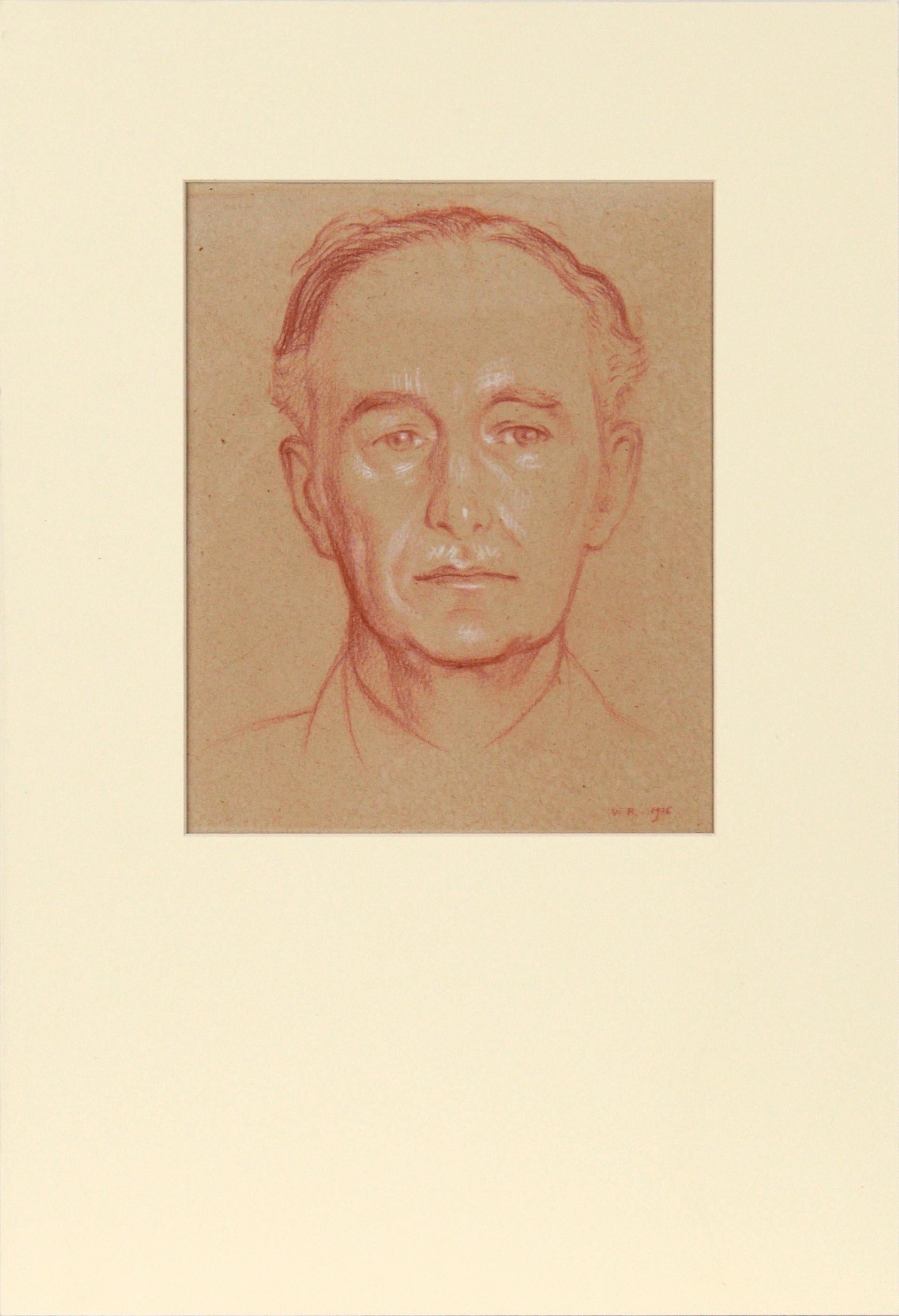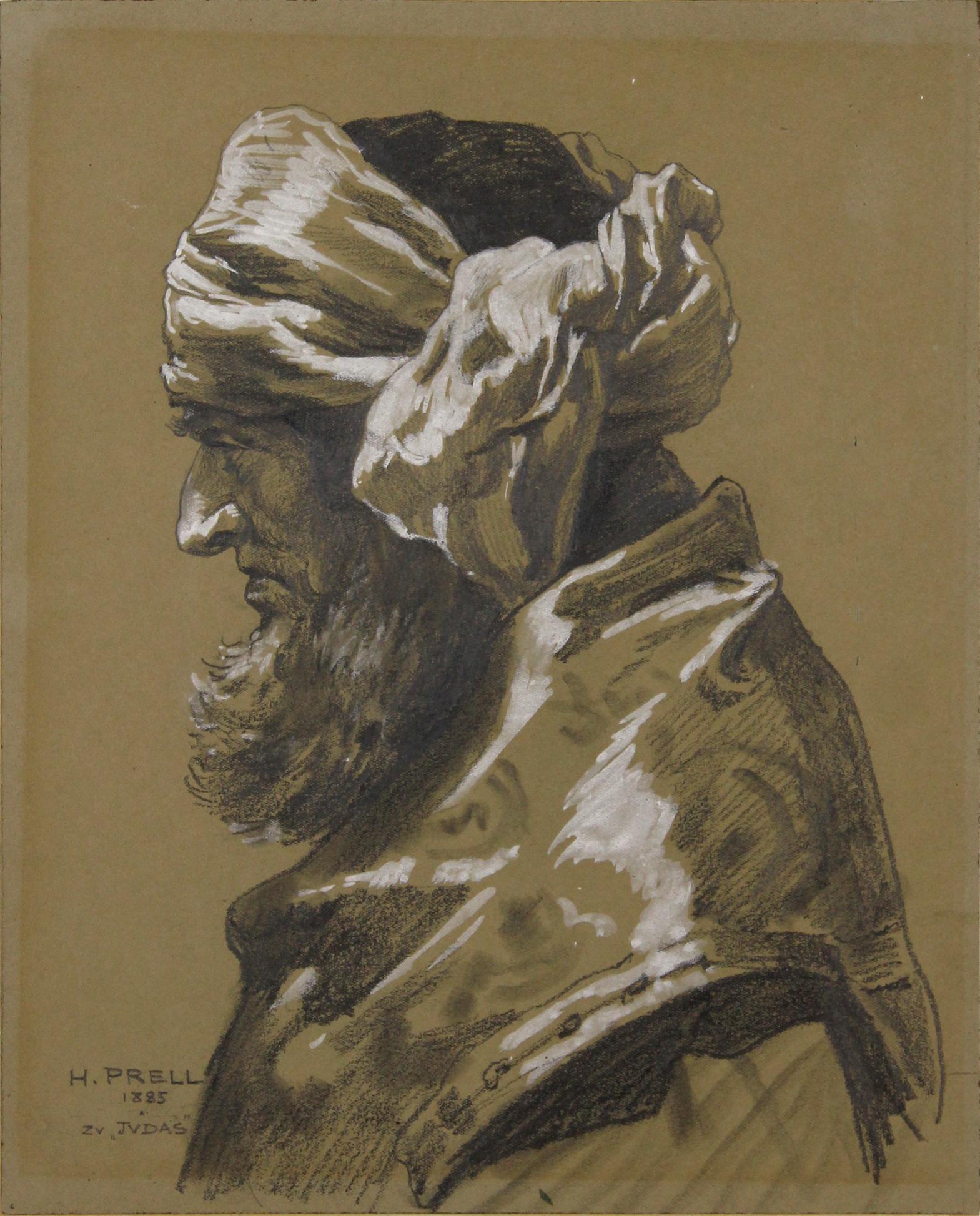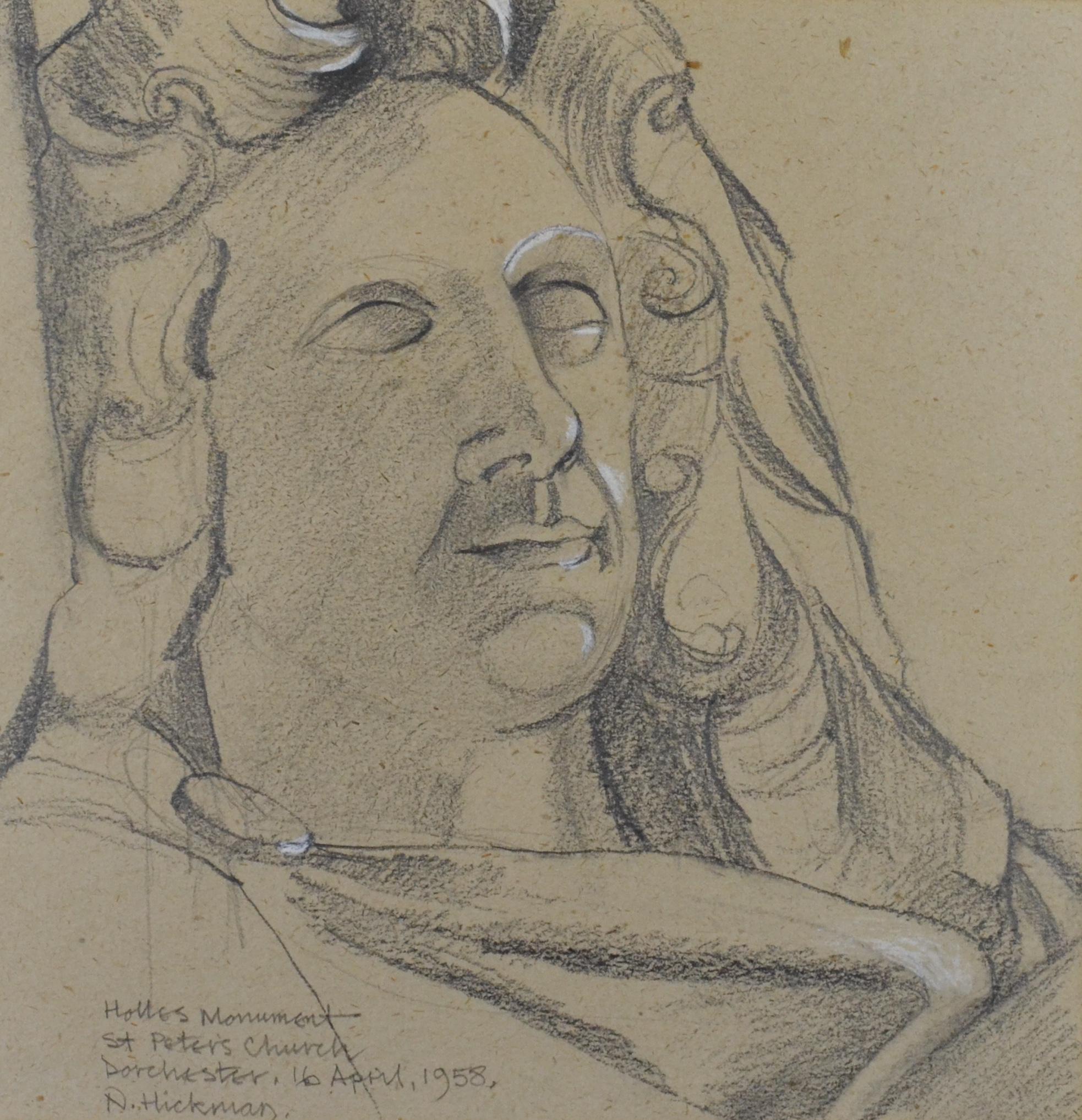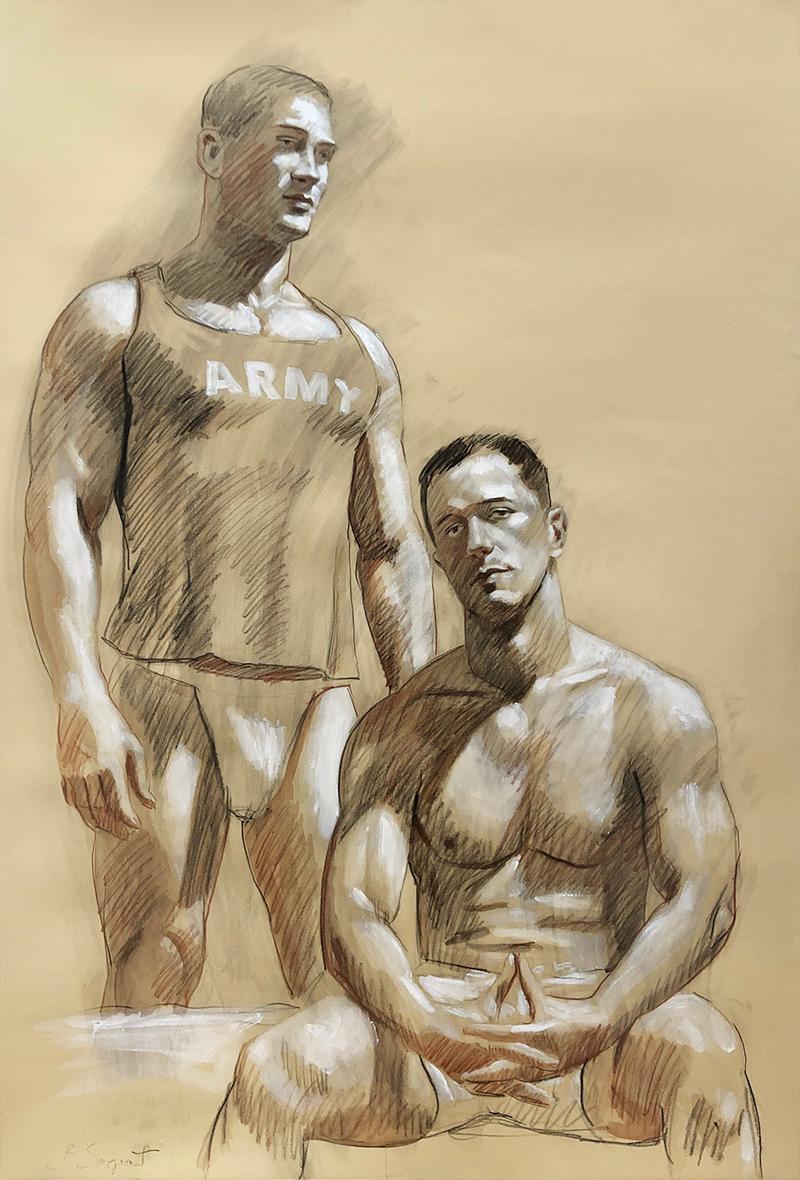Items Similar to Portrait of a Lady - British art Post Impressionist 40s drawing female portrait
Want more images or videos?
Request additional images or videos from the seller
1 of 12
Edward Bainbridge CopnallPortrait of a Lady - British art Post Impressionist 40s drawing female portrait circa 1940
circa 1940
About the Item
A dramatic head and shoulders portrait of a lady in coloured chalks attributed to noted British artist Edward Bainbridge Copnall. This is just a stunning artwork which dates to circa 1940.
Signed Bainbridge Copnall.
Provenance. Midlands collection.
Condition. Coloured chalks on paper, 16 inches by 13 inches and in good colour and condition. Some staining to edges.
Housed in its original gallery frame 21 by 18 inches. In excellent condition.
Edward Bainbridge Copnall MBE ( 1903-1973) was a British sculptor and painter. He was best known for his architectural and decorative sculptures featuring allegorical and religious subjects. He was the President of the Royal Society of Sculptors from 1961 - 1966. Edward Bainbridge Copnall was born in Cape Town, South Africa in 1903 and moved to Horsham, West Sussex in England as a young child after the death of his mother. His father, photographer Edward White Copnall (born 1878, Isle of Wight), lived and worked in Horsham from 1915-1962. His uncle was Liverpool-based portrait painter Frank Thomas Copnall (1870-1948). The Copnall family have a long association with Horsham, the street Copnall Way is named after them. The exterior sculptural scheme for the Royal Institute of British Architects new building in Portland Place, London, completed in 1934, was an important early commission. In the Second World War, he worked as a camouflage officer in the Middle East, building dummies as part of the military deception for Operation Crusader. Copnall lived in Burma from 1955 to 1956, and completed 50-60 paintings, mainly portraits, during that time. He was also commissioned to do a memorial of General Aung San, the first Prime Minister of Free Burma. The statue was unveiled in Burma in 1955. He was president of the Royal Society of British Sculptors from 1961 to 1966. Bainbridge Copnall wrote A Sculptor's Manual, published in 1971, and Cycles: An Autobiography - The Life and Work of a Sculptor, published in 2001. His son is artist John Copnall (1928-2007).
- Creator:Edward Bainbridge Copnall (1903 - 1970)
- Creation Year:circa 1940
- Dimensions:Height: 21 in (53.34 cm)Width: 18 in (45.72 cm)Depth: 2 in (5.08 cm)
- Medium:
- Movement & Style:
- Period:
- Condition:
- Gallery Location:London, GB
- Reference Number:1stDibs: LU853113061512
About the Seller
5.0
Platinum Seller
These expertly vetted sellers are 1stDibs' most experienced sellers and are rated highest by our customers.
1stDibs seller since 2018
402 sales on 1stDibs
Typical response time: 1 hour
- ShippingRetrieving quote...Ships From: London, United Kingdom
- Return PolicyA return for this item may be initiated within 14 days of delivery.
More From This SellerView All
- Portrait of a Lady - British Art Deco 30's drawing young woman good provenanceBy Hubert John WilliamsLocated in London, GBA fine and detailed Art Deco pencil, black, red and white chalk portrait of a young woman by Hubert Williams. The work dates to circa 1930 and is very skilful in its execution. A bea...Category
1930s Realist Portrait Drawings and Watercolors
MaterialsChalk, Color Pencil
- Portrait of a Lady - Scottish art early 20thC drawing society woman hat cameoLocated in London, GBThis is a fine circa 1910 pencil drawing of a Scottish society lady. Executed by one of the leading artists of the day in the circle of John Lavery it is a very striking and fascina...Category
19th Century Realist Portrait Drawings and Watercolors
MaterialsCharcoal, Pencil
- Portrait of a Young Woman - 1930's Art Deco portrait drawing British artistBy James StroudleyLocated in London, GBA fine large charcoal and pencil drawing by British listed artist James Stroudley. Executed in 1931, it is a stunning example of a 1930s Art Deco portrait. Very strong and bold, it d...Category
1930s Realist Portrait Drawings and Watercolors
MaterialsCarbon Pencil
- Portrait of Decima Moore - Actress & Suffragette Edwardian drawing female artistBy Maria Cowell nee SayerLocated in London, GBA fine, circa 1907, Edwardian pencil / charcoal drawing. Executed by Maria Cowell nee Sayer, it depicts a portrait of Decima Moore - an actress and Suffragette. A very striking and f...Category
Early 1900s Realist Portrait Drawings and Watercolors
MaterialsCharcoal, Carbon Pencil
- Portrait of a Seated Lady - French 1880 Victorian art female portrait drawingLocated in London, GBThis lovely pencil and charcoal drawing is attributed to circle of French noted artist Jacques Joseph Tissot. Created around 1880 the drawing is of a woman relaxing on a reclining chair...Category
19th Century Realist Portrait Drawings and Watercolors
MaterialsCharcoal, Pencil
- Nude Female - Italian British art Edwardian nude portrait drawing female artistBy Estella CanzianiLocated in London, GBThis is a fine detailed and superbly executed Edwardian drawing by Estella Canziani which dated to circa 1911. Drawn by one of the leading artists of the day, it is a very striking a...Category
1910s Realist Nude Drawings and Watercolors
MaterialsCarbon Pencil
You May Also Like
- Portrait of Leopold Myers by Sir William RothensteinBy Sir William RothensteinLocated in Soquel, CAStately sanguine portrait of Leopold Hamilton Myers (Novelist) by Sir William Rothenstein (English, 1872-1945). Captured in Rothenstein's characteristic style, Myers looks directly at the viewer with a neutral expression. Although this portrait uses only two colors and minimal shading, the likeness of Myers is incredibly well captured. Leo (Leopold) Hamilton Myers (1881 – 1944) was a British novelist. Numerous examples like this one of the writer are in the Tate Museum. Initialed and dated in the lower right corner ("W.R. 1936") Inscription on verso indicating materials, subject, and artist. Presented in a new cream colored mat with foamcore backing. Mat size: 18"H x 12"W Paper size: 15.25"H x 10.75"W William Rothenstein (English, 1872-1945) was born into a German-Jewish family in Bradford, West Yorkshire. His father, Moritz, emigrated from Germany in 1859 to work in Bradford's burgeoning textile industry. Soon afterwards he married Bertha Dux, and they had six children, of which William was the fifth. Rothenstein was knighted in 1931. Rothenstein left Bradford Grammar School at the age of sixteen to study at the Slade School of Art*, London (1888-1893), where he was taught by Alphonse Legros, and the Académie Julian* in Paris (1889-1893), where he met and was encouraged by James McNeill Whistler, Edgar Degas and Henri Toulouse-Lautrec. Whilst in Paris he also befriended the Anglo-Australian artist Charles Conder, with whom he shared a studio in Montmartre. In 1893 he returned to England to work on "Oxford Characters" a series of lithographic* portraits. In Oxford he met and became a close friend of the caricaturist* and parodist Max Beerbohm, who later immortalised him in the short story Enoch Soames (1919). During the 1890s Rothenstein exhibited with the New English Art Club* and, in 1900, won a silver medal for his painting The Doll's House at the Exposition Universelle. In 1898 he co-founded the Carfax Gallery in St. James' Piccadilly with John Fothergill. During its early years the gallery was closely associated with such artists as Charles Conder, Philip Wilson Steer, Charles Ricketts and Augustus John. It also exhibited the work of Auguste Rodin, whose growing reputation in England owed much to Rothenstein's friendship and missionary zeal. The gallery was later the home for all three exhibitions of The Camden Town Group*, led by Rothenstein's friend and close contemporary Walter Sickert. Rothenstein is best known for his portrait drawings of famous individuals and for being an official war artist in both World War I and World War II. He was also a member of the International Society of Sculptors, Painters & Gravers. The style and subject of his paintings varies, though certain themes reappear, in particular an interest in 'weighty' or 'essential' subjects tackled in a restrained manner. Good examples include Parting at Morning (1891), Mother and Child (1903) and Jews Mourning at a Synagogue (1907) - all of which are owned by the Tate Gallery. The National Portrait Gallery owns over two hundred of his portraits. In 2011 the BBC and the Public Catalogue Foundation began cataloguing all of his paintings in public ownership online. Between 1902 and 1912 Rothenstein lived in Hampstead, London, where his social circle included such names as H.G.Wells, Joseph Conrad and the artist Augustus John. Amongst the young artists to visit Rothenstein in Hampstead were Mark Gertler...Category
1930s Realist Portrait Drawings and Watercolors
MaterialsConté, Handmade Paper
- Reverie - Early 20th Century British chalk drawing of a girl by H J HarveyBy Herbert Johnson HarveyLocated in London, GBHERBERT JOHNSON HARVEY (British 1883-1956) Reverie Signed with monogram and dated l.l.: HJ 09 Red chalks Framed 29.5 by 22 cm., 11 ¾ by 8 ¾ in. (fra...Category
Early 20th Century Realist Portrait Drawings and Watercolors
MaterialsChalk
- Sketch of a head - Carved in stone -Located in Berlin, DEEmil Faesch (1865 Basel - 1915 Basel). Sketch of a head. Charcoal on painting cardboard, 60 x 47.5 cm (folio size), signed and dated at lower right "E. Faesch. 1888.". Minor browning. - Carved in stone - About the artwork The life-size head has an immensely present presence. This effect is due to the fact that Faesch took his cue from academic classical...Category
1880s Realist Figurative Drawings and Watercolors
MaterialsChalk
- Half-length portrait of a Pharisee - In the shadow of betrayal -Located in Berlin, DEHermann Prell (1854 Leipzig - 1922 Dresden-Loschwitz). Half-length portrait of a Pharisee, 1885. Sketch for the right-hand figure in the painting Judas Iscariot, 1886. Pencil drawing heightened with opaque white and black chalk on beige-grey wove paper (papier vélin), 34 x 27.8 cm (visible size), 52 x 45 cm (mount), signed, dated and inscribed "H. PRELL 1885 zu 'Judas'". Minor browning, collection stamp on the reverse. - In the shadow of betrayal - About the artwork This painting is the sketch for the head of the Pharisee offering the coins to Judas in one of Herrmann Prell's major works, the painting Betrayal of Judas, completed in 1886. The painting belongs to the Staatliche Kunstsammlungen Dresden and is illustrated in Adolf Rosenberg: Prell, Bielefeld and Leipzig 1901, p. 21 (Fig. 19). It is especially highlighted in Thieme-Becker (vol. 27, p. 376). Hermann Prell, Betrayal of Judas, 1886 The monumental head, which fills the picture and is distinguished by its ornamented robe, is almost a lost profile, which in the executed painting is justified by the Pharisee's turning towards Judas. Despite the fact that the sitter withdraws from the viewer by turning away, it was necessary to artistically elaborate the motivation for the purchase of one of Christ's disciples, which is why the drawing focuses on the expression of the face, while the 'accessories' are treated in a more summary manner. In characterising the face, Hermann Prell performs a balancing act: since the Pharisee, despite his destructive actions, is an actor in the history of salvation, the head must show a dignity appropriate to the event, but at the same time the physiognomy must also bear witness to the scheming attitude that led to the betrayal. To solve this dilemma, Prell draws on the traditional depictions of the heads of the apostles, shading the face to indicate the obdurate darkness of the spirit and moving the base of the nose slightly upwards while the mouth falls away, thus giving a physiognomic expression to the motivation of the action. The fatal drama of the betrayal is expressed in the monumentalisation of the head and in the thunderous white highlights that contrast with the darkness of the chalk. As a study, considered by the artist to be a work in itself, this drawing reveals the pictorial problems and brainstorming of monumental painting. About the artist In 1872 Prell, who was one of the most important exponents of monumental painting of his time, began studying painting with Theodor Grosse at the Dresden Academy of Art and continued with Carl Gussow at the Berlin Academy in 1876. Hans von Marées taught him in Rome in 1878. More influential on his work, however, were Arnold Böcklin and Max Klinger, with whom Prell had been friends since his student days and with whom he worked together on several occasions. Prell's first major work, which established his reputation as a monumental painter, were the frescoes in the banqueting hall of the Architektenhaus in Berlin in 1881/82, commissioned by the state and depicting the different periods of architecture. Prell then went to Italy for two years to study fresco painting. Other major commissions followed. These included monumental frescoes in the town halls of Worms (1884), Hildesheim (1882-92), Gdansk (1895) and Dresden, the staircase of the Silesian Museum of Fine Arts in Breslau (1893/94), the throne room of the German Embassy in Rome (1896-99) and the staircase of the Albertinum in Dresden (1900-1904). From 1886 Prell taught at the academy of arts in Berlin and in 1892 he was appointed professor at the academy of arts in Dresden. His students included Osmar Schindler and Hans Unger...Category
1880s Realist Figurative Drawings and Watercolors
MaterialsChalk
- Monument to Denzil Holles, Dorchester - 1950s drawing by British ArtistBy Neville HickmanLocated in London, GBNEVILLE HICKMAN (20th Century) Monument to Denzil Holles, Dorchester Signed, inscribed and dated: Holles Monument, St Peter’s Church, Dorchester, 16 April 1958. Chalks heightened ...Category
1950s Realist Still-life Drawings and Watercolors
MaterialsChalk
- Two MenBy Mark BeardLocated in New York, NYCharcoal with red and white conté crayon on Rives BFK paper Signed in pencil, l.l. This artwork is offered by ClampArt, located in New York City. Mark Beard, born in 1956 in Salt L...Category
21st Century and Contemporary Realist Figurative Drawings and Watercolors
MaterialsConté, Paper, Charcoal
Recently Viewed
View AllMore Ways To Browse
Drawing Of A House
Architect Drawing
Collection Of Architectural Drawings
Drawings By Architects
Drawings Of A Child
40s Painting
40s Paintings
Drawing Of Child
Portrait Of A Lady
Antique Architectural Drawings
Original Architect Drawing
Military Portrait
British Sculptor
British Portrait Drawing
Female Impressionist
Post Impressionist Portraits
Antique Portrait Of A Lady
1915 Portraits





